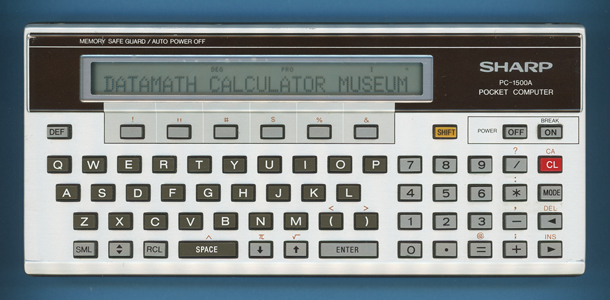
DATAMATH CALCULATOR MUSEUM
 |
DATAMATH CALCULATOR MUSEUM |
Sharp PC-1500, PC-1500A, PC-1501
| Date of introduction: | January 1982 | Display technology: | LCD dot matrix |
| New price: | $279.00 (MSRP 1982) | Display size: | 26 characters |
| Size: | 3.4" x 7.7" x 1.0" 86 x 195 x 26 mm3 |
||
| Weight: | 11.8 ounces, 336 grams | Serial No: | 57157417 |
| Batteries: | 4*AA Alkaline | Date of manufacture: | mth 07 year 1985 |
| AC-Adapter: | EA-150 (9V DC, 500mA) | Origin of manufacture: | Japan |
| Precision: | 12 | Integrated circuits: | CPU: LH5801 ROM: SC613128 RAM: 2*TC5514P, HM6116 I/O: LH5810 or LH5811 CLOCK: uPD1990AC DISPLAY: 4*SC882G |
| Memories: | 1.8k-7.8k RAM, 16k ROM | ||
| Program steps: | Courtesy of: | Joerg Woerner |

![]() Sharp
Corporation introduced in June 1980 with the PC-1210 (and its sibling
PC-1211) the World's first Pocket Computer with BASIC programmability.
It took only about three months and Matsushita defined with their
Panasonic HHC a new category of
Hand-held Computers or Portable Computers. Casio, having a long history of
Programmable Pocket Calculators, entered the arena in November 1981 with their
FX-702P, combining a scientific calculator with BASIC programmability in the new
"landscape" form factor with wide LC-Displays and an alphanumeric keyboard.
Sharp
Corporation introduced in June 1980 with the PC-1210 (and its sibling
PC-1211) the World's first Pocket Computer with BASIC programmability.
It took only about three months and Matsushita defined with their
Panasonic HHC a new category of
Hand-held Computers or Portable Computers. Casio, having a long history of
Programmable Pocket Calculators, entered the arena in November 1981 with their
FX-702P, combining a scientific calculator with BASIC programmability in the new
"landscape" form factor with wide LC-Displays and an alphanumeric keyboard.
With the three cornerstones of the emerging market defined, Sharp consequently split their portfolio into two different directions:
| • PC-1500 (1982): Portable Computer as a center of a Computer System with many peripherals • PC-1401 (1983): Hybrid of a Pocket Computer with BASIC Programmability and a Scientific Calculator |
The main differences between the PC-1500 introduced in 1982 and the PC-1500A/PC-1501 (Japan) introduced in 1984 is the capacity of the integrated RAM. While the PC-1500 makes use of two TC5514P chips for the system memory and one HP6116 RAM with 2k Bytes capacity for the user memory, features the PC-1500A/PC-1501 one HM6264 chip with 8k Bytes capacity.
Learn how to decipher the 57157417 Date code hidden in the serial number of the pictured calculator.
![]()
![]() The PC-1500 architecture features not only an internal expansion slot for a
memory cartridge but a 60-pin connector for peripherals on its left side. Sharp introduced
a whole slew of accessories for its PC-1500 Computer System:
The PC-1500 architecture features not only an internal expansion slot for a
memory cartridge but a 60-pin connector for peripherals on its left side. Sharp introduced
a whole slew of accessories for its PC-1500 Computer System:
| Product | Description | MSRP (1982) |
| CE-150 | 4-color Printer/Plotter & Cassette Interface | |
| CE-151 | 4k Bytes RAM module | |
| CE-152 | Cassette recorder | |
| CE-155 | 8k Bytes RAM module | |
| CE-157 | 4k Bytes RAM module with backup battery | |
| CE-158 | Communication dock with Serial and Parallel interface | |
| CE-159 | 8k Bytes RAM module with backup battery | |
| CE-160 | 7.6k Bytes ROM module with backup battery | |
| CE-161 | 16k Bytes RAM module with backup battery | |
| CE-162E | Parallel Port & Cassette Interface | |
| CE-163 | 2*16k Bytes paged RAM module with backup battery |
Dismantling a Sharp PC-1500 or PC-1500A/PC-1501 reveals a complex design centered around a Sharp LH5801 8-bit microprocessor:
| • LH5801: 8-bit microprocessor manufactured by Sharp
in a CMOS process and using a 76-pin QFP (Quad Flat Pack) package • SC613128 or LH536701: 16k Bytes ROM manufactured by Sharp in a CMOS process and using a 54-pin or 44-pin QFP (Quad Flat Pack) package • 2*TC5514P: 1k*4 Bits RAM manufactured by Toshiba in a CMOS process and using an 18-pin DIP (Dual In-line Package) encapsulation • HM6116 or HM6264: 2k Bytes or 8k Bytes RAM manufactured by Hitachi in a CMOS process and using an 24-pin or 28-pin SOP (Small Outline Package) encapsulation • LH5810 or LH5811: I/O Controller with 3 parallel Ports, 1 serial port and CS logic manufactured by Sharp in a CMOS process and using a 60-pin QFP (Quad Flat Pack) package • uPD1990C: Real-time Clock manufactured by NEC in a CMOS process and using a 14-pin DIP (Dual In-line Package) encapsulation • 4*SC882G: Display driver with built in RAM (128*4 Bits), manufactured by Sharp in a CMOS process and using a 62-pin QFP (Quad Flat Pack) package |
If you have additions to the above article please email: joerg@datamath.org.
© Joerg Woerner, January 3, 2021. No reprints without written permission.